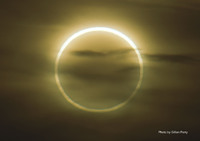Solar experiences for 2011

Whilst the UK’s snow clouds and urban skylines may have obscured this morning’s Lunar Eclipse for many early risers, there’s still every chance that 4 January’s Partial Solar Eclipse will overshadow today’s celestial performance.
Taking place every two to three years, this Eclipse is due to start before sunrise at 06.40hrs and the partially eclipsed sun expected to rise shortly after 08.00hrs, when a third of the sun will be hidden by the Moon. As with all Solar Eclipses, it remains unwise to look directly at the Sun to enjoy this display but to project its image on to a white background.
January will also play host to a number of other natural spectacles making ‘amateur astronomy’ the easiest New Year’s resolution to stick to.
These natural shows include Jupiter and Uranus being extremely close to each other on 3 and 5 January – an alignment that occurs only ever 14 years – and the annual Quadrantid meteor shower, whose peak is expected around midnight on 3 January. During this period, those with binoculars or telescopes may be able to make out some of Jupiter’s four major moons though the meteor show should be visible to the naked eye.
Claire Wilson, MD of Explorers Astronomy Tours – with 25 years’ experience of organising Solar Eclipse expeditions and astronomy tours around the world – comments: “January will be a rare opportunity for Brits to indulge their curiosity about the wonders of the skies with minimal effort and from the comfort of their home. Furthermore, BBC Two’s proposed scheduling of three nights of live stargazing to coincide with the increased activity should help bring the excitement of the universe to a new audience, young and old.”
Wonderful though these events will be, nothing surpasses the extraordinary experience of a Total Solar Eclipse when day turns to night and an eerie silence descends. The next opportunity to enjoy such a display will be 2012 which is set to prove a special year for eclipse viewing.
Explorers Astronomy Tours’ new brochure features eight different itineraries to enjoy both the Annular Solar Eclipse (US, 20 May 2012 – prices from £1599pp with flights) and the Total Solar Eclipse (Australia, 14 November 2012 – prices from £1799pp with flights). For both events, Southern Utah and Queensland have been chosen as viewing locations to combine a stunning landscape with the high probability of clear skies to enjoy the Eclipse.
The holiday options cater for the time-pressed keen to simply experience the Eclipse, astronomy enthusiasts interested in combining their visit with the best local observatories as well as those looking to take advantage of the distance travelled to explore the spectacular scenery. From Hawaii and the Grand Canyon to the Great Barrier Reef and New Zealand, all combine optimal viewing conditions with some of the world’s most iconic landscapes.
Groups will have Explorer’s ‘Galactic Ranger’ - acclaimed astronomer and expedition guide Dr John Mason MBE - on hand to explain the phenomenon, ensuring the holiday is as suited to first-time astronomers as regular followers of the sun’s spectacular shows.
Wilson concludes: “We hope that the upcoming phenomena will help open people’s eyes to the chance of exploring the skies as they travel the world. As our resident expert Dr John Mason always says, there are books that list 100 things to do before you die and a Total Eclipse should definitely be on that list.”
To find out more visit: astronomytours.co.uk

